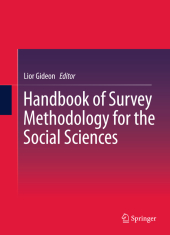 Neuerscheinungen 2012Stand: 2020-01-07 |
Schnellsuche
ISBN/Stichwort/Autor
|
Herderstraße 10
10625 Berlin
Tel.: 030 315 714 16
Fax 030 315 714 14
info@buchspektrum.de |

Lior Gideon
Handbook of Survey Methodology for the Social Sciences
Ed. by Lior Gideon
2012. 2012. xviii, 520 S. 36 Tabellen. 254 mm
Verlag/Jahr: SPRINGER, BERLIN 2012
ISBN: 1-461-43875-6 (1461438756)
Neue ISBN: 978-1-461-43875-5 (9781461438755)
Preis und Lieferzeit: Bitte klicken
Surveys enjoy great ubiquity among data collection methods in social research: they are flexible in questioning techniques, in the amount of questions asked, in the topics covered, and in the various ways of interactions with respondents. Surveys are also the preferred method by many researchers in the social sciences due to their ability to provide quick profiles and results. Because they are so commonly used and fairly easy to administer, surveys are often thought to be easily thrown together. But designing an effective survey that yields reliable and valid results takes more than merely asking questions and waiting for the answers to arrive.
Geared to the non-statistician, the Handbook of Survey Methodology in Social Sciences addresses issues throughout all phases of survey design and implementation. Chapters examine the major survey methods of data collection, providing expert guidelines for asking targeted questions, improving accuracy and quality of responses, while reducing sampling and non-sampling bias. Relying on the Total Survey Error theory, various issues of both sampling and non-sampling sources of error are explored and discussed. By covering all aspects of the topic, the Handbook is suited to readers taking their first steps in survey methodology, as well as to those already involved in survey design and execution, and to those currently in training.
Featured in the Handbook:
- The Total Survey Error: sampling and non-sampling errors.
- Survey sampling techniques.
- The art of question phrasing.
- Techniques for increasing response rates
- A question of ethics: what is allowed in survey research?
- Survey design: face-to-face, phone, mail, e-mail, online, computer-assisted.?
- Dealing with sensitive issues in surveys.
- Demographics of respondents: implications for future survey research.
- Dealing with nonresponse, and nonresponse bias
The Handbook of Survey Methodology in Social Sciences offers how-to clarity for researchers in the social and behavioral sciences and related disciplines, including sociology, criminology, criminal justice, social psychology, education, public health, political science, management, and many other disciplines relying on survey methodology as one of their main data collection tools.
AcknowledgmentIntroductionClassification of surveysSurvey Ethics: What are we Allowed to do in Survey ResearchThe Salient Bias in Survey Research: Total Survey Error (TSE)Common Survey Sampling TechniquesFrames, Framing effects, and Survey ResponseThe Art of Question PhrasingInterviewingUnit nonresponse due to refusalControling for response error, and quality of responseWhy do people agree to participate in surveysRespondents Coopertation: Demographic profile of survey respondents and its implications Effects of incentives in surveysDesigning the face to face surveyRepeated Cross-sectional surveys using FTFCost and error in fixed and mobiile phone surveysmail Surveys in social researchE-mail SurveysIncreasing response rate in web-based/ internet surveysHow to build your own online survey panelDoes paying more mean getting better product: Comparison of Surey Modes of AdministrationSensitive issues in surveys: Reducing refusals while increasing reliability and quality of responseResearching difficult populations: Interviewing techniques and methodological issues in FTF...What survey modes are most effective in eliciting self-reports of criminal or delinquent behaviorIssues in survey desing: using Survey of victimization and fear of crime as examples What would you do? Conducting web-based factorial vignette surveysComparability of survey measurmentsEmployee Surveys as Catalysts for Change: Turning data into action


